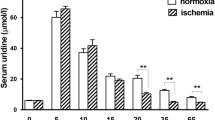Abstract
The effect of intravenous infusion of glutamic acid on cardiac contractile function during short-term ischemia and subsequent reperfusion was studied in anaesthetized dogs. Left ventricular ischemia was induced by underperfusion of the anterior descending and circumflex coronary arteries. Infusion of glutamic acid at 3 mg/kg/min resulted in less depression of cardiac function when given after a 2 min period of 60% coronary blood flow reduction: left ventricular systolic pressure decreased by 9% vs. 22%,dP/dt decreased by 16% vs. 29%, the double product (left ventricular systolic pressure by heart rate) was reduced by 16% vs. 31%. When reperfusion was carried out during glutamic acid infusion there was a significantly enhanced recovery in cardiac function. The augmentation of cardiac performance in ischemia and reperfusion caused by glutamic acid was not accompanied by changes in myocardial oxygen consumption. Glutamic acid uptake by the ischemic myocardium increased 2-fold during infusion. This led to cessation of ammonia release from the heart due to stimulation of glutamine synthesis, and an enhancement of alanine formation coupled with pyruvate uptake but it did not effect lactate production. However, glutamic acid infusion did not influence cardiac performance and metabolism under conditions of normal coronary flow. The results suggest that elevation of glutamate arterial concentration exerts a beneficial effect on ischemic heart. The mechanisms of the protective action are discussed.
Similar content being viewed by others
References
Barrio JR, Egbert JE, Henze E (1982)l-(4-11C)Aspartic acid: Enzymatic synthesis, myocardial uptake and metabolism. J Med Chem 25:93–96
Bittl J, Shine KI (1983) Protection of ischemic rabbit myocardium by glutamic acid. Am J Physiol 245:H406-H412
Dennis SC, Shattock MJ, Hearse DJ, Ball MR, Sochor M, McLean P (1983) Two different metabolic responses to ischemia: inherent variability or artefact? Cardiovasc Res 17:489–498
Dixon WJ, Brown MG (1977) Biomedical computing programs, P series, Berkeley University of California Press
Engelman RM, Dobbs WA, Rousou JH, Meeran MK (1982) Myocardial high-energy phosphate replenishment during ischemic arrest: aerobic versus anaerobic metabolism. Ann Thorac Surg 33:453–458
Gutman I, Wahlefeld AW (1974)l-Lactat. Bestimmung mit lactatdehydrogenase und NAD. In: Bergmeyer HU (Hrsg) Methoden der enzymatischen Analyse, Band 2. Verlag Chemie, Weinheim, S. 1510–1514
Katunuma N, Okada M, Nishi Y (1966) Regulation of urea cycle and TCA cycle by ammonia. Adv Enzym Regul 4:317–336
Kirkendol PL, Perason JE, Robie N (1980) The cardiac and vascular effect of sodium glutamate. Clin Exp Pharmacol Physiol 617–625
Knapp WH, Helus F, Ostertag H, Tillmanns H, Kübler W (1982) Uptake and turnover ofl-(13N) glutamate in the normal human heart and in patients with coronary artery disease. Eur J Nucl Med 7:211–215
LaNoue K, Walajtys EI, Williamson JR (1973) Regulation of glutamate metabolism and interactions with the citric acid cycle in rat heart mitochandria. J Biol Chem 250:7171–7183
Lazar HL, Buckberg GD, Mangarano AJ, Becker H (1980) Myocardial energy replenishment and reversal of ischemic damage by substrate enhancement of secondary blood cardioplegia with amino acids during reperfusion. J Thorac Cardiovasc Surg 80:350–359
Mudge GH, Mills RH, Taegtmeyer H, Gorlin R, Lesch M (1976) Alterations of myocardial amino acid metabolism in chronic ischemic heart disease. J Clin Invest 58:1185–1192
Owen TG, Hochachka PW (1974) Purification and properties of dolphin muscle aspartate and alanine transaminase and their possible role in the energy metabolism of diving mammals. Biochem J 143:541–553
Passoneau JV, Lowry OH (1974) Pyruvate Fluorimetrische Bestimmung. In: Bergmeyer HU (Hrsg) Methoden der enzymatischen Analyse, Band 2. Verlag Chemie, Weinheim, S. 1497–1501
Pisarenko OI, Artemov AV, Smirnov VN (1980) Study of nitrogen metabolism in the cardiac muscle using the isotope15N. In: Energy, transport, protein synthesis and hormonal control of heart metabolism, NIH Publication, Bethesda, pp 329–351
Pisarenko OI, Studneva IM, Smirnov VN (1983a)15N study of myocardial ammonia metabolism. ZFI-Mitt 77:290–308
Pisarenko OI, Solomatina ES, Studneva IM, Ivanov VE, Kapelko VI, Smirnov VN (1983b) Protective effect of glutamic acid on cardiac function and metabolism during cardioplegia and reperfusion. Basic Res Cardiol 78:534–543
Pisarenko OI, Solomatina ES, Studneva IM, Ivanov VE, Kapelko VI, Smirnov VN (1983c) Effect of glutamic and aspartic acids on adenine nucleotides, nitrogen compounds and contractile function during underperfusion of isolated rat heart. J Mol Cell Cardiol 15:53–60
Pozefski T, Tancredi RG (1972) Effect of intrabranchial arterial infusion of pyruvate on forearm tissue metabolism. Interaction between pyruvate, lactate and alanine. J Clin Invest 52:2359–2369
Rau EE, Schine KI, Gervais A, Douglas AM, Amos EC (1979) Enhanced mechanical recovery of anoxic and ischemic myocardium by amino acid reperfusion. Am J Physiol 236:4873–4879
Rosenkranz ER, Buckberg GD, laks H, Mulder DE (1983) Warm induction of cardioplegia with glutamate-enriched blood in coronary patients with cardiogenic shock who dependent on inotropic drugs and intra aortic ballon support. J Thorac Cardiovasc Surg 86:507–518
Safer B (1975) The metabolic significance of the malate-aspartate cycle in heart. Circ Res 37:527–533
Scheffé H (1959) The analysis of variance. John Wiley and Sons, New York
Shertzer HG, Cascarano J (1979) Anaerobic rat heart: mitochondrial role in calcium uptake and contractility. J Exp Zool 207:337–350
Weiner JM, Apetzin CS, Arthur JH, Pirsada FA, Hood WB (1976) Persistence of myocardium injury following brief period of coronary occlusion. Cardiovasc Res 10:678–686
Weiss J, Couper GS, Hiltbrand B, Shine KI (1984) Role of acidosis in early contractile dysfunction during ischemia: evidence from pHo measurements. Am J Physiol 247:H760-H767
Williamson IR, Schaffer SW, Ford Ch, Safer B (1973) Contribution of tissue acidosis of ischemic injury in the perfused rat heart. Circulation 53:(Suppl 1) 3–14
Wyatt HL, Forrester JS, Tyberg IV, Goldner S, Logan SE, Parmley WW, Swan HJC (1975) Effect of graded reduction in regional coronary perfusion on regional and total cardiac function. Am J Cardiol 36:185–192
Author information
Authors and Affiliations
Rights and permissions
About this article
Cite this article
Pisarenko, O.I., Novikova, E.B., Serebryakova, L.I. et al. Function and metabolism of dog heart in ischemia and in subsequent reperfusion: effect of exogenous glutamic acid. Pflugers Arch. 405, 377–383 (1985). https://doi.org/10.1007/BF00595691
Received:
Accepted:
Issue Date:
DOI: https://doi.org/10.1007/BF00595691




